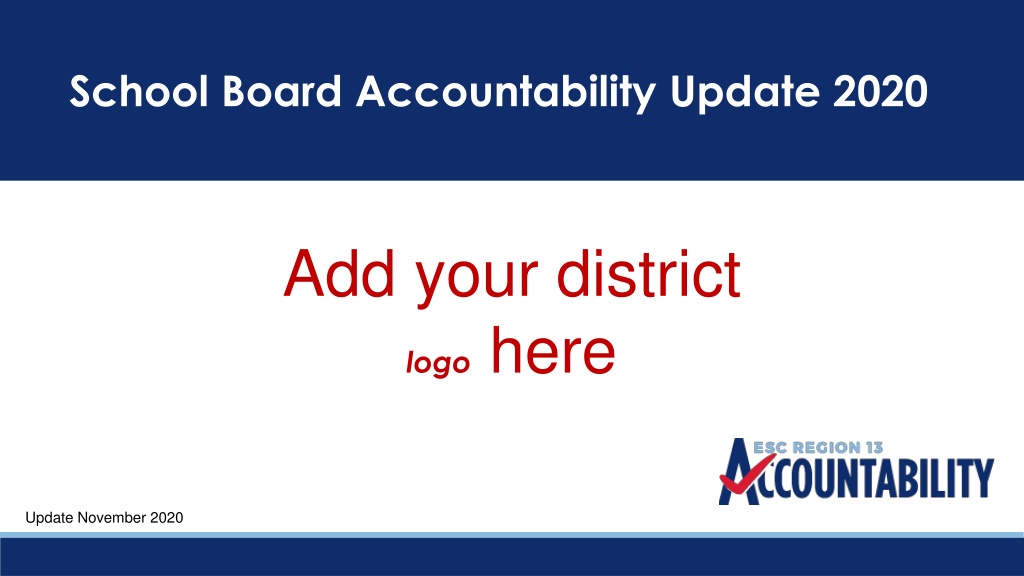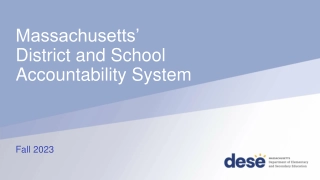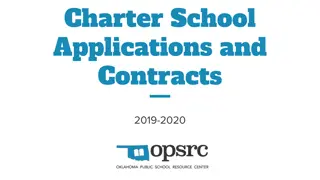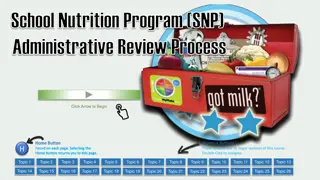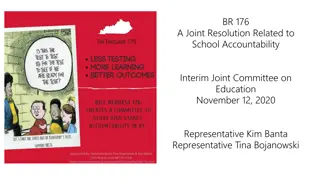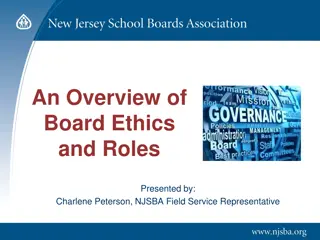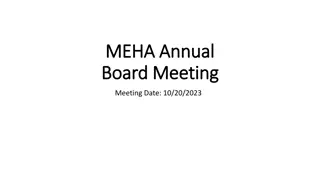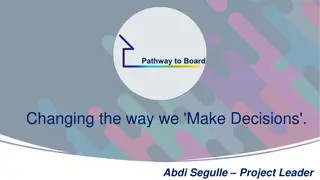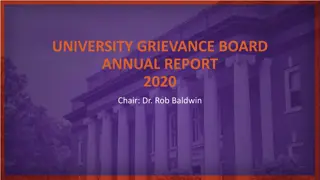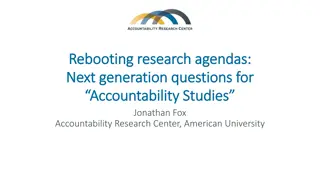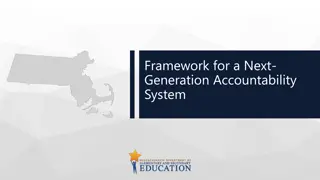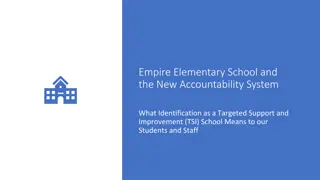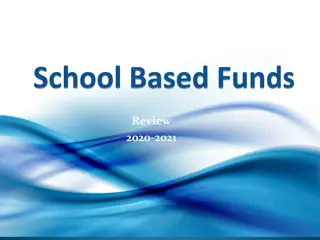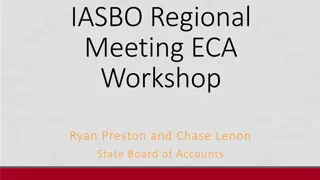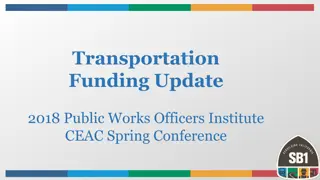School Board Accountability Update 2020 Overview
The School Board Accountability Update for 2020 highlights the impact of COVID-19 on district and campus ratings, addressing the challenges faced by schools during the pandemic. The A-F Accountability System, district and campus ratings, and next steps are discussed, emphasizing the need for stakeholders' feedback and solutions. The overview also covers the accountability labels/grades assigned and the domains used for calculating overall accountability ratings.
Download Presentation

Please find below an Image/Link to download the presentation.
The content on the website is provided AS IS for your information and personal use only. It may not be sold, licensed, or shared on other websites without obtaining consent from the author.If you encounter any issues during the download, it is possible that the publisher has removed the file from their server.
You are allowed to download the files provided on this website for personal or commercial use, subject to the condition that they are used lawfully. All files are the property of their respective owners.
The content on the website is provided AS IS for your information and personal use only. It may not be sold, licensed, or shared on other websites without obtaining consent from the author.
E N D
Presentation Transcript
School Board Accountability Update 2020 Add your district logo here Update November 2020
School Board Accountability Update 2020 2019-2020: DUE TO COVID-19 AND THE STATE RATING OF NOT RATED: DECLARED STATE OF DISASTER FOR ALL CAMPUSES AND DISTRICTS, SCHOOL BOARDS AND SUPERINTENDENTS MAY WISH TO REFERENCE THE PREVIOUS YEARS ACCOUNTABILITY REPORTS, AS WELL AS DISTRICT AND CAMPUS RATINGS. Update November 2020
Review A-F Accountability System Review District Ratings Objectives Review Campus Ratings Next Steps
A-F Accountability Labels/Grades 2020 Ratings All districts and campuses will be assigned a label of Not Rated: Declared State of Disaster for 2020 accountability as was shared in the April 2 To the Administrator Addressed (TAA). Due to the 2020 Not Rated: Declared State of Disaster label, campuses identified for the Public Education Grant (PEG) list based on 2019 accountability ratings will remain on the 2021 22 PEG List. The list of 2021 22 PEG campuses will be released on August 14. 2021 Ratings The agency is working with stakeholders, advisory committees, the U.S. Department of Education (USDE), and other states to gather feedback, identify issues, and develop solutions for the impact of COVID-19 on 2021 accountability. Due to COVID-19, the USDE placed a hold on processing any amendments, waivers, or requests that were not COVID-19 related. The Every Student Succeeds Act (ESSA) accelerated testers waiver, which was open for public comment in March, is on-track for submission to the USDE this week. The submitted waiver request will be published on TEA s ESSA page.
A-F Accountability Labels/Grades A = Exemplary Performance Scaled Score 90-100 B = Recognized Performance Scaled Score 80-89 C = Acceptable Performance Scaled Score 70-79 D = In Need of Improvement Scaled Score 60-69 F = Unacceptable Performance Scaled Score 59
Three Domains: Calculating an Overall Accountability Rating Domain Letter Grade Domain Letter Grade Domain Letter Grade Best of Achievement OR Progress 70% Overall Letter Grade 30% =
Overview 7
Student Achievement Domain Performance 8 8
Student Achievement Domain Calculating the Score STAAR One point is given for each percentage of assessment results that are at or above the following: Approaches Grade Level or above Meets Grade Level or above Masters Grade Level Percentage of Assessments at Approaches Grade Level or above + Percentage of Assessments at Meets Grade Level or above + Percentage of Assessments at Masters Grade Level Three 9 9
Student Achievement Domain CCMR Indicators for High School Career Ready College Ready Earn industry-based certification Meet criteria of 3 on AP or 4 on IB examinations Meet TSI criteria (SAT/ACT/TSIA/College Prep course) in reading and mathematics Complete a course for dual credit (9 hours or more in any subject or 3 hours or more in ELAR/ mathematics) Earn an associate s degree Complete an OnRamps Course and earn college credit CTE coherent sequence coursework completion and credit aligned with approved industry-based certifications (one-half point credit) Graduate with completed IEP and workforce readiness (graduation type code of 04, 05, 54, or 55) Earn a Level I or Level II certificate Graduate under an advanced degree plan and be identified as a current special education student Military Ready Enlist in the United States Armed Forces 10
Student Achievement Domain CCMR Indicators for High School College, Career, and Military Ready A new College, Career, and Military Readiness (CCMR) Verifier for 2019 graduates and non- graduating 12th graders has been released. The CCMR Verifier will be a TEAL version of last year s CCMR corrections system which occurred in April and May. Districts will have through October 1 to submit documentation for updates. Additional information and instructions will be forthcoming as they are available. A new CCMR Tracker has been released. The CCMR Tracker will provide data on students reported as enrolled in grades 9 12 on the TSDS PEIMS 2019 snapshot date. No corrections will be submitted to TEA; this report is for informational purposes only. If districts find errors, they are encouraged to work with testing vendors to make corrections prior to the student s graduation. The agency is currently awaiting college enrollment and military enlistment data to determine CCMR Outcomes Bonuses. Additional information will be forthcoming as it is available. 11
Student Achievement Domain Graduation Rate Graduation Rate High school graduation rates include the four-year, five-year, or six- year longitudinal graduation rate (with state exclusions) or annual dropout rate, if the graduation rate is not available. Example Calculation: Graduation Rate All Students Graduation Rate 90.9% Class of 2018, 4-year Class of 2017, 5-year 91.4% 90.0% Class of 2016, 6-year 91.4 Graduation Rate Score
Student Achievement Domain Score Component Score Scaled Score Rating Add District Name Here STAAR Performance CCMR Graduation Rate 13
School Progress Domain Part A: Part B: Academic Growth Relative Performance Best of Academic Growth OR Relative Performance 15
School Progress Domain Part A: Academic Growth Part A: Academic Growth School Progress, Part A: Academic Growth includes all assessments with a STAAR progress measure. Districts and campuses (including high schools) earn credit for results that maintain proficiency or meet growth expectations on STAAR.
School Progress Domain Part B: Relative Performance Part B: Relative Performance High Schools, K 12, and Districts with CCMR Component Student Achievement STAAR component and CCMR component results averaged compared to districts or campuses with similar percentages of economically disadvantaged students as reported in the TSDS PEIMS October snapshot. Part B: Relative Performance High Schools, K 12, and Districts without CCMR Component Student Achievement STAAR component results compared to districts or campuses with similar percentages of economically disadvantaged students Part B: Relative Performance AEA Districts and Campuses Alternative education accountability (AEA) districts and campuses are not evaluated on School Progress, Part B due to the small number of districts and campuses used for comparison.
School Progress Domain Score Component Score Scaled Score Rating Add District Name Here Part A: Academic Growth Part B: Relative Performance 18
Closing the Gaps Domain 14 Student Groups All Students African American Hispanic White American Indian Asian Pacific Islander Two or More Races Economically Disadvantaged Current Special Education Former Special Education Current and Monitored English Learners Continuously Enrolled Non-Continuously Enrolled
Closing the Gaps Domain 4 Components English Language Proficiency The English Language Proficiency component measures an EL s progress towards achieving English language proficiency. Current ELs are the only students evaluated in this component. School Quality or Student Success STAAR component of the Student Achievement domain for elementary and middle schools College, Career, and Military Readiness (CCMR) Performance Status component for high schools, K 12s, and districts If a high school, K 12, or district does not have CCMR data, STAAR component is used, if available. Academic Achievement: STAAR Performance Status at the Meets Grade Level or above standard in English language arts (ELA)/reading and mathematics Growth or Graduation Academic Growth Status: The School Progress, Part A domain data in reading and mathematics for elementary and middle schools Federal Graduation Status: The four-year federal graduation rate (without exclusions) for high schools, K 12s, and districts with graduation rates. If a high school, K 12, or district does not have graduation data, Academic Growth Status is used, if available.
2018 Alternative Education Accountability 2019 Alternative Education Accountability AEA charter schools and campuses will be able to earn bonus points which will be added to the overall scaled score. A maximum of ten bonus points may be applied to an AEA s overall scaled score. AEA charter schools and campuses may earn up to five points for each of the following two indicators: Credit for graduation plan type awards AEA charter schools and campuses bonus points for the percentage of graduates who graduate under either a RHSP, DAP, FHSP-E, or FHSP-DLA graduation plan. Credit for EOC retest assessments awards AEA charter schools and campuses bonus points for the percentage of EOC retest assessments at the Approaches Grade Level standard or above.
Closing the Gaps Domain Score Add District Name Here Component Score Scaled Score Rating Closing the Gaps 24
Enter Your District Name Here Campus Summary Student Achievement Closing the Gaps Overall School Progress Support Label Campus Name Part A: Rating Part A: Score Part B: Rating Part B: Score Rating Score Rating Score Rating Score Met 68 Met 67 Met 70 Impr. Req 59 Met 77 Add. Target SAMPLE EL Standard Standard Standard Standard Met 68 NOT RATED NOT RATED NOT RATED NOT RATED BEST EL Standard Met 68 NOT RATED NOT RATED NOT RATED NOT RATED WONDERFUL EL SAMPLE INT Standard Met 71 Met 73 Impr. Req 59 Met 69 Met 66 Add. Target Standard Standard Standard Standard Met 91 Met 80 Met 93 Met 82 Met 87 Add. Target SAMPLE MIDDLE SAMPLE HS Standard Standard Standard Standard Standard Met 81 Met 84 Met 69 Met 80 Met 73 Add. Target Standard Standard Standard Standard Standard
A F Accountability Distinction Designations
Distinction Designations Distinction Designations are awarded in the following areas: Academic Achievement in English Language Arts/Reading (campus only) Academic Achievement in Mathematics (campus only) Academic Achievement in Science (campus only) Academic Achievement in Social Students (campus only) Top 25 percent: Comparative Academic Growth (campus only) Top 25 percent: Comparative Closing the Gaps (campus only) Postsecondary Readiness (district and campus)
Add DD here Add District Name Here Distinction Designations 30
Comprehensive and Additional Targeted Support and Improvement
Comprehensive Support and Improvement Campuses that were rated Comprehensive Support, Targeted Support, Additional Target Support, and Improvement will retain those ratings for 2020-2021 and continue to follow and implement required supports in 2020-2021. Comprehensive Support The Closing the Gaps domain scaled score will be used to rank and identify schools for comprehensive support. The agency will identify at least the lowest five percent of Title I, Part A campuses, based on the CTG scaled score, for comprehensive support. For 2018, the lowest five percent CTG scaled score cut point was 47. The 2019 the lowest five percent CTG scaled score cut point is 42.
Targeted Support and Improvement Targeted Support and Improvement TEA uses the Closing the Gaps domain to identify campuses that have consistently underperforming student groups. TEA defines a consistently underperforming student group as one that does not meet at least three of the same indicator targets for three consecutive years. Campuses will be identified annually for the first time in 2019 based on 2017, 2018, and 2019 data.
Additional Targeted Support and Improvement Additional Targeted Support and Improvement Identification Any campus that is not identified for comprehensive or targeted support and improvement will be identified for additional targeted support if an individual student group s percentage of evaluated indicators met is at or below the percentage used to identify that campus type for comprehensive support. Any campus that had a student group that met ZERO indicators was identified as additional targeted support
Add District Name Here Comprehensive and Additional Targeted Support Campuses 35
Add District Name Here Next Steps 36
